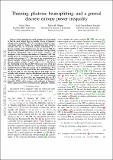Thinning, photonic beamsplitting, and a general discrete Entropy power Inequality
Author(s)
Guha, Saikat; Sanchez, Raul Garcia-Patron; Shapiro, Jeffrey H
DownloadShapiro_Thinning, photonic.pdf (378.4Kb)
OPEN_ACCESS_POLICY
Open Access Policy
Creative Commons Attribution-Noncommercial-Share Alike
Terms of use
Metadata
Show full item recordAbstract
Many partially-successful attempts have been made to find the most natural discrete-variable version of Shannon's entropy power inequality (EPI). We develop an axiomatic framework from which we deduce the natural form of a discrete-variable EPI and an associated entropic monotonicity in a discrete-variable central limit theorem. In this discrete EPI, the geometric distribution, which has the maximum entropy among all discrete distributions with a given mean, assumes a role analogous to the Gaussian distribution in Shannon's EPI. The entropy power of X is defined as the mean of a geometric random variable with entropy H(X). The crux of our construction is a discrete-variable version of Lieb's scaled addition X⊞[subscript η] Y of two random variables X and Y with η ∈ (0, 1). We discuss the relationship of our discrete EPI with recent work of Yu and Johnson who developed an EPI for a restricted class of random variables that have ultra-log-concave (ULC) distributions. Even though we leave open the proof of the aforesaid natural form of the discrete EPI, we show that this discrete EPI holds true for variables with arbitrary discrete distributions when the entropy power is redefined as eH(X) in analogy with the continuous version. Finally, we show that our conjectured discrete EPI is a special case of the yet-unproven Entropy Photon-number Inequality (EPnI), which assumes a role analogous to Shannon's EPI in capacity proofs for Gaussian bosonic (quantum) channels.
Date issued
2016-08Department
Massachusetts Institute of Technology. Department of Electrical Engineering and Computer ScienceJournal
2016 IEEE International Symposium on Information Theory (ISIT)
Publisher
Institute of Electrical and Electronics Engineers (IEEE)
Citation
Guha, Saikat et al. “Thinning, Photonic Beamsplitting, and a General Discrete Entropy Power Inequality.” 2016 IEEE International Symposium on Information Theory (ISIT), July 10-15 2016, Barcelona, Spain, Institute of Electrical and Electronics Engineers (IEEE), August 2016: 705-709 © 2016 Institute of Electrical and Electronics Engineers (IEEE)
Version: Original manuscript
ISBN
978-1-5090-1806-2
ISSN
2157-8117